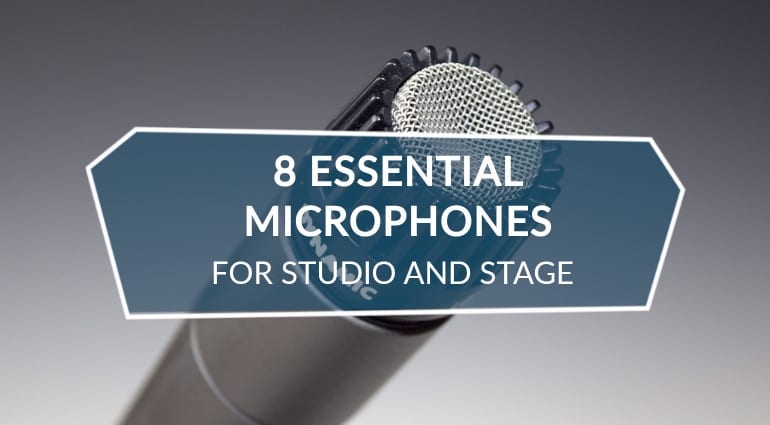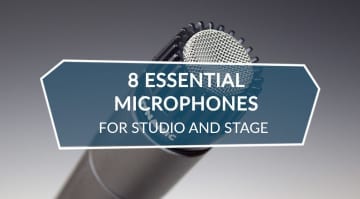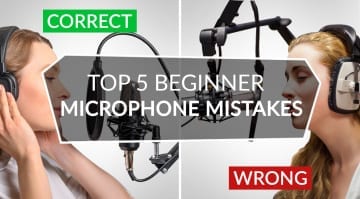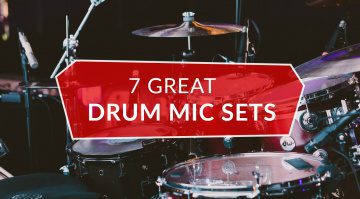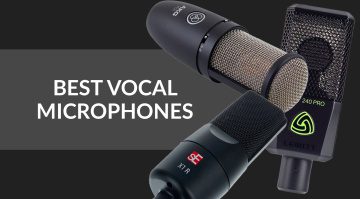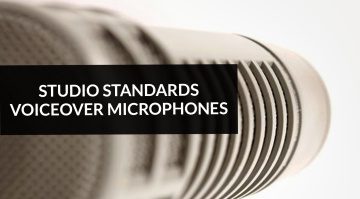Must-have Mics: 8 Essential Microphones for Studio and Stage
From basement club gigs and bedroom studios, through to stadiums and super-studios; certain microphones shine through as classics and “must-haves”. Here’s our list of 8 Essential Microphones for all applications and all budgets…
So what makes for an “essential microphone”? For the most part an essential microphone is one that becomes a “go-to” anytime you’re looking to mic-up a particular instrument. An engineer, whether live or in the studio, needs to be prepared for any situation. Having a well-equipped mic box, with a tool for every situation, will not only result in great-sounding mixes, but it will also get you hired back for future gigs.
We’ve chosen 8 Essential Microphones, pulled from our own experiences both in the studio and on stage. There’s a range of microphones here from dynamic through to condenser and even ribbon microphones. You can buy the cheapest microphones here for under €100, but if you’re on a budget don’t worry; these microphones represent the industry standard style of microphone for each instrument source. Alternatives are available at all price points; if you’re in any doubt, don’t hesitate to contact our friends at Thomann for advice on the best mic for your application and budget!
So, without further ado, let’s get down to our list of 8 essential microphones…
Shure SM57
Shure’s SM57 is the cheapest microphone on this list; and yet you’ll find it in multi-million dollar studios as well as grotty dive bars alike. If you’re after something to point at a snare drum or a guitar cab, the SM57 is a great place to start. Able to handle massive sound pressure levels, it’s a legend for reliability and durability. In a pinch, you can use an SM57 on every single instrument source, including vocals, and it’ll turn out OK.
Shure SM58
The sister microphone to the SM57, the SM58 is the defacto live vocal microphone. For many of you, an SM58 is likely to have been your first microphone purchase. Essentially an SM57 with an integrated windscreen, no mic collection is complete without at least one SM58.
Sennheiser MD421
Originally introduced in the 1960s, the Sennheiser MD421 is a legendary dynamic microphone. You’ll find that it excels on loud sound sources and offers a transparent yet smooth reproduction. Superb on guitar cabs, you’ll really hear the nuances of your amp and cabinet with one of these in front. The MD421 is also great on brass such as trumpets and trombones. Where the MD421 really excels is as a studio standard for toms and percussion; its thick, meaty low-mid response really adds heft to percussive sources.
Shure Beta 52a
No mic box is complete without a dedicated “kick drum microphone” and the Shure Beta 52a is an excellent choice. It sounds great on just about any kick drum and can be EQ’d easily to fit genres from jazz and pop through to rock and metal. You’ll also find the Beta 52a a good choice for bass guitar cabs and even lower-pitched brass instruments. Basically, anywhere you have a low end voiced instrument and you need it to cut through, whack a Beta 52a in front of it!
Neumann KM184
A small-diaphragm condenser microphone is an often overlooked, yet essential tool in any microphone box. Small diaphragm condenser microphones excel at reproducing fast transients with accuracy and transparency. For many engineers, the Neumann KM184 is the go-to small-diaphragm condenser microphone. You’ll find the KM184 outstanding on Hi-Hats and cymbals as well as a superb choice for acoustic instruments such as acoustic guitars, violins and other string instruments.
AKG C414
The AKG C414 is a large-diaphragm condenser microphone which is unique here in offering multiple polar patterns. In the studio, being able to switch between the omnidirectional, figure of 8 and cardioid/super-cardioid patterns can really aid creativity. You’ll see C414s being used on stages and studios the world over as it’s something of an industry-standard for drum overheads and grand pianos. Let’s not forget that it’s also an outstanding choice as a studio vocal microphone too!
Beyerdynamic M88
The Beyerdynamic M88 is a well-kept secret amongst studio and stage engineers alike, but we’re happy to share it with you as this is a superb microphone. A dynamic microphone, the M88 is characterised by ruler-flat frequency response and high SPL handling. Put in front of any vocalist, a skilled engineer can EQ this mic to sound amazing on pretty much anyone. The M88 is also amazing on low-frequency sources such as kick drums and bass cabs.
Coles 4038
And finally, here’s the curve-ball of our line-up of 8 Essential Microphones! The Coles 4038 is the oldest microphone design here, being originally designed by BBC back in 1953! It’s a ribbon microphone and also offers a figure 8 polar pattern; we’d recommend leaving this one in the studio. So why is it here then? Well, if you’ve never heard a ribbon microphone you’re in for a treat! Unbelievably smooth, the 4038 has the ability to round off edges and sweeten and smooth sources. Try using a 4038 anywhere you’d use a large-diaphragm condenser and be amazed at how sweet smooth and airy your mix now sounds. Many saxophone players swear by them and on drum overheads cymbals sound heavenly. If you ever have the chance to use or own a Coles 4038, don’t hesitate!
 5,0 / 5,0 |
5,0 / 5,0 | 